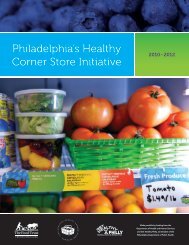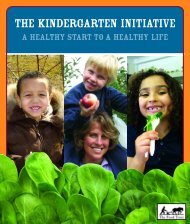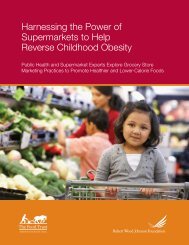The Grocery Gap: Who Has Access to Healthy - The Food Trust
The Grocery Gap: Who Has Access to Healthy - The Food Trust
The Grocery Gap: Who Has Access to Healthy - The Food Trust
You also want an ePaper? Increase the reach of your titles
YUMPU automatically turns print PDFs into web optimized ePapers that Google loves.
PolicyLink<strong>The</strong> <strong>Food</strong> <strong>Trust</strong>76Tsai, S. Needs Assessment: <strong>Access</strong> <strong>to</strong> Nutritious<strong>Food</strong>s in East Oakland and South Hayward. [Master’s<strong>The</strong>sis]. Berkeley, CA: University of California atBerkeley School of Public Health and AlamedaCounty Public Health Department, 2003.77Unger, S., and Wooten, H. A <strong>Food</strong> SystemsAssessment For Oakland, CA: Toward ASustainable <strong>Food</strong> Plan. [Master’s <strong>The</strong>sis]. Berkeley,CA: Oakland Mayor’s Office of Sustainabilityand University of California, Berkeley, 2006.78Wang, M., Kim, S., Gonzalez, A., MacLeod,K., and Winkleby, M. “Socioeconomic and<strong>Food</strong>-Related Physical Characteristics of theNeighborhood Environment are Associated withBody Mass Index.” Journal of Epidemiologyand Community Health 61 (2007): 491–498.79Zenk, S.H., Schulz, A. J., Hollis-Neely, T., Campbell,R.T., Watkins, G., Nwankwo, R., and Odoms-Yound,A. “Fruit and Vegetable Intake in African AmericansIncome and S<strong>to</strong>re Characteristics.” AmericanJournal of Preventive Medicine 20, no.1 (2005).80Zenk, S., Schulz, A., Israel, B., James, S., Bao, S.,and Wilson, M. “Neighborhood Racial Composition,Neighborhood Poverty, and the Spatial <strong>Access</strong>ibilityof Supermarkets in Metropolitan Detroit.” AmericanJournal of Public Health 95 (2005): 660–667.81Zenk, S., Schulz, A., Israel, B., Sherman, J., Bao,S., and Wilson, M. “Fruit and Vegetable <strong>Access</strong>Differs by Community Racial Composition andSocioeconomic Position in Detroit, Michigan.”Ethnicity & Disease 16 (2006): 275-280.82Fresno Metro Ministry. Fresno Fresh <strong>Access</strong>:Community <strong>Food</strong> Assessment Report. 2003-2005. Fresno, CA: Fresno Metro Ministry,2005. Available at http://fresnometmin.org/fmm/pdfs/CFA_Summary_9-14-05.pdf.83Kaufman, L., and Karpati, A. <strong>Food</strong> Matters: WhatBushwick Families’ <strong>Food</strong> Habits Teach us aboutChildhood Obesity. New York, NY: New York CityDepartment of Health and Mental Hygiene, 2007.84Fulfrost, B. Mapping the Markets: <strong>The</strong> RelativeDensity of Retail <strong>Food</strong> S<strong>to</strong>res in Densely PopulatedCensus Blocks in the Central Coast Region ofCalifornia. Santa Cruz, CA: University of California,Santa Cruz, 2006. Available at http://casfs.ucsc.edu/research/Mapping<strong>The</strong>Markets.pdf.85Williams, D. <strong>Food</strong> Security and <strong>Access</strong>in Akron Ohio. [Master’s <strong>The</strong>sis]. Akron,OH: University of Akron, 2002.86San Francisco <strong>Food</strong> Alliance. 2005 San FranciscoCollaborative <strong>Food</strong> System Assessment. SanFrancisco, CA: San Francisco <strong>Food</strong> Alliance, 2005.87California Center for Public Health Advocacy.Searching for <strong>Healthy</strong> <strong>Food</strong>: <strong>The</strong> <strong>Food</strong> Landscape inCalifornia Cities and Counties. Davis, CA: CaliforniaCenter for Public Health Advocacy, 2007.88Andrews, M., Kan<strong>to</strong>r, L., Lino, M., andRipplinger, D. “Using USDA’s Thrifty <strong>Food</strong> Plan<strong>to</strong> Assess <strong>Food</strong> Availability and Affordability.”<strong>Food</strong> <strong>Access</strong> 24, no.2. (2001): 45-53.89Block, D., and Kouba, J. “A Comparison of theAvailability and Affordability of a Market Basketin Two Communities in the Chicago Area.” PublicHealth Nutrition 9, no.7 (2006): 837–845.90Lopez, R. Community <strong>Food</strong> Security inConnecticut: An Evaluation and Rankingof 169 Towns. S<strong>to</strong>rrs, CT: Hartford <strong>Food</strong>System, 2005. Available at http://www.hartfordfood.org/pubs/cfs_connecticut.pdf.91Moore L., Roux, A., Nettle<strong>to</strong>n, J., andJacobs, D. “Associations of the Local <strong>Food</strong>Environment with Diet Quality—A Comparison ofAssessments Based on Surveys and GeographicInformation Systems: <strong>The</strong> Multi-Ethnic Studyof Atherosclerosis.” American Journal ofEpidemiology 167 (2008): 917–924.92Raja, S., Ma, C., and Yadav, P. “Beyond<strong>Food</strong> Deserts: Measuring and MappingRacial Disparities in Neighborhood <strong>Food</strong>Environments.” Journal of Planning Educationand Research 27 (2008): 469-482.93Rose, D., Bodor, N., Swalm, C., Rice, J., Farley,T., and Hutchinson, P. Deserts in New Orleans?Illustrations of Urban <strong>Food</strong> <strong>Access</strong> and Implicationsfor Policy. Ann Arbor, MI: University of MichiganNational Poverty Center/USDA Economic ResearchService Research, 2009. Available at http://www.npc.umich.edu/news/events/food-access/rose_et_al.pdf.94Sekhobo, J., and Berney, B. “<strong>The</strong> Relation ofCommunity Occupational Structure and Prevalenceof Obesity in New York City Neighborhoods—An Ecological Analysis.” Journal of Hunger &Environmental Nutrition 3, no.1 (2008): 76-83.36






